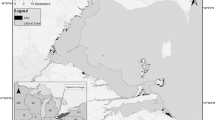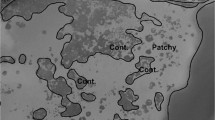Abstract
In the event of a natural or anthropogenic disturbance, environmental resource managers require a reliable tool to quickly assess the spatial extent of potential damage to the seagrass resource. The temporal availability of the Landsat 5 Thematic Mapper (TM) imagery provided a suitable option to detect and assess damage of the submerged aquatic vegetation (SAV). This study examined Landsat TM imagery classification techniques to create two-class (SAV presence/absence) and three-class (SAV estimated coverage) SAV maps of the seagrass resource. The Mahalanobis Distance method achieved the highest overall accuracy (86%) and validation accuracy (68%) for delineating the seagrass resource (two-class SAV map). The Maximum Likelihood method achieved the highest overall accuracy (74%) and validation accuracy (70%) for delineating the seagrass resource three-class SAV map. The Landsat 5 TM imagery classification provided a seagrass resource map product with similar accuracy to the aerial photointerpretation maps (validation accuracy 71%). The results support the application of remote sensing methods to analyze the spatial extent of the seagrass resource.
Similar content being viewed by others
References
Andreu, M. G., Friedman, M. H., Landry, S. M., & Northrop, R. J. (2008). City of Tampa urban ecological analysis 2006–2007. Final Report to the City of Tampa, 24 April 2008, City of Tampa, Florida.
Andrefouet, S., Kramer, P., Torres-Pulliza, D., Joyce, K. E., Hochberg, E. J., Garza-Perez, R., et al. (2003). Multi-site evaluation of IKONOS data for classification of tropical coral reef environments. Remote Sensing of Environment, 88, 128–143.
Chauvaud, S., Bouchon, C., & Manieres, R. (1998). Remote sensing techniques adapted to high resolution mapping of tropical coastal marine ecosystems (coral reefs, seagrass beds, and mangrove). International Journal of Remote Sensing, 19(18), 3625–3639.
Cooper, S. T. (Ed.) (2010). In Proceedings, Tampa Bay Area Scientific Information Symposium, BASIS 5: 20–23 October 2009. Twenty years of Tampa Bay seagrass mapping and analysis, St. Petersburg, FL (p. 538).
Dekker, A. G., Brando, V. E., & Anstee, J. M. (2005). Retrospective seagrass change detection in a shallow coastal tidal Australian Lake. Remote Sensing of Environment, 97, 415–433.
ESRI (2006). ESRI ArcMap 9.2. Redlands, CA: Environmental Systems Research Institute, Inc.
Fyfe, S. K. (2003). Spatial and temporal variation in spectral reflectance: Are seagrass species spectrally distinct? Limnology and Oceanography, 48(1), 464–479.
Gullström, M., Lundén, B., Bodin, M., Kangwe, J., Öhman, M. C., Mtolera, M. S. P., et al. (2006). Assessment of changes in the seagrass-dominated submerged vegetation of tropical Chwaka Bay (Zanzibar) using satellite remote sensing. Estuarine Coastal and Shelf Science, 67, 399–408.
Hawth (2006). Hawth’s analysis tools version 3.27. Developer: Hawthorne L. Beyer. http://www.spatialecology.com/htools/.
ITT (2006). ENVI version 4.3. Boulder, CO: ITT Industries, Inc.
Jensen, J. R. (2005). Introductory digital image processing: A remote sensing perspective, 3rd Edn. New Jersey: Prentice Hall.
Kaufman, K. (2007). Southwest Florida water management district, unpublished data.
Kirkman, H. (1996). Baseline and monitoring methods for seagrass meadows. Journal of Environmental Management, 47, 191–201.
Kurz, R. C. (2002). Seagrass mapping: Accuracy issues, 209–213. In H. S. Greening (Ed.), Seagrass management: It’s not just nutrients, 22–24 Aug 2000, St. Petersburg, FL, TBEP (p. 246).
Levy, K. L., Flock, M., & Meyer, C. A. (2008). Pinellas County ambient water quality monitoring report. Pinellas County Watershed Management, 300 South Garden Avenue, Clearwater, Florida, 33756.
Meyer, C. A., & Levy, K. (2008). Seagrass resource assessment & monitoring report: 1998–2007. Pinellas County Watershed Management, 300 South Garden Avenue, Clearwater, Florida, 33756.
Mumby, P. J., Green, E. P., Edwards, A. J., & Clark, C. D. (1999). The cost-effectiveness of remote sensing for tropical coastal resources assessment and management. Journal of Environmental Management, 55, 157–166.
Mumby, P. J., & Edwards, A. J. (2002). Mapping marine environments with IKONOS imagery: Enhanced spatial resolution can deliver greater thematic accuracy. Remote Sensing of Environment, 82, 248-257.
Pasqualini, V., Pergent-Martini, C., Pregent, G., Agreil, M., Skoufas, G., Sourbes, L., & Tsirika, A. (2005). Use of SPOT 5 for mapping seagrasses: An application to Posidonia oceania. Remote Sensing of Environment, 94, 39–45.
Schmidt, K. S., & Skidmore, A. K. (2003). Spectral discrimination of vegetation types in a coastal wetland. Remote Sensing of Environment, 85, 92–108.
Schweizer, D., Armstrong, R. A., & Posada, J. (2005). Remote sensing characterization of benthic habitats and submerged vegetation biomass in Los Roques Archipelago National Park, Venezuela. International Journal of Remote Sensing, 26(12), 2657–2667.
Shapiro, A. C., & Rohmann, S. O. (2006). Mapping changes in submerged aquatic vegetation using Landsat imagery and benthic habitat data: Coral reef ecosystem monitoring in Vieques Sound between 1985 and 2000. Bulletin of Marine Science, 79(2), 375–388.
Short, F. T., & Coles, R. G. (Eds.) (2001). Global research methods. Amsterdam: Elsevier Science B.V.
SWFWMD (2006). 2006 and 2005 natural color imagery for Pinellas County [computer file, Geographic Information System Mr SID raster files], Southwest Florida Water Management District, Brooksville, Florida. URL: http://www.swfwmd.state.fl.us/data/gis/doqq_search.htm.
Thorhaug, A., Richardson, A. D., & Berlyn, G. P. (2007). Spectral reflectance of the seagrasses: Thalassia testudinum, Halodule wrightii, Syringodium filiforme and five marine algae. International Journal of Remote Sensing, 28(7), 1487–1501.
Tomasko, D. A., Corbett, C. A., Greening, H. S., & Raulerson, G. E. (2005). Spatial and temporal variation in seagrass coverage in Southwest Florida: Assessing the relative effects of anthropogenic nutrient load reductions and rainfall in four contiguous estuaries. Marine Pollution Bulletin, 50, 797–805.
Author information
Authors and Affiliations
Corresponding author
Rights and permissions
About this article
Cite this article
Meyer, C.A., Pu, R. Seagrass resource assessment using remote sensing methods in St. Joseph Sound and Clearwater Harbor, Florida, USA. Environ Monit Assess 184, 1131–1143 (2012). https://doi.org/10.1007/s10661-011-2028-4
Received:
Accepted:
Published:
Issue Date:
DOI: https://doi.org/10.1007/s10661-011-2028-4




